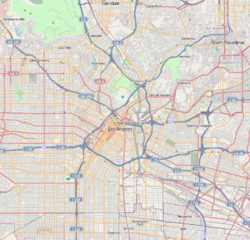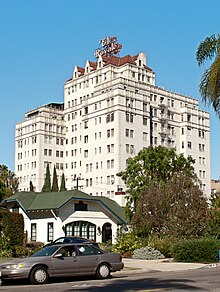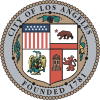world.wikisort.org - USA
Hancock Park is a neighborhood in the Wilshire area of Los Angeles, California.[2] Developed in the 1920s, the neighborhood features architecturally distinctive residences, many of which were constructed in the early 20th century. Hancock Park is covered by a Historic Preservation Overlay Zone (HPOZ).
This article uses bare URLs, which are uninformative and vulnerable to link rot. (September 2022) |
Hancock Park | |
|---|---|
Neighborhood of Los Angeles | |
 Hancock Park Neighborhood Signage at Melrose Avenue and Highland Avenue | |
 Hancock Park Location within Central Los Angeles | |
| Coordinates: 34.07619°N 118.33348°W | |
| Country | |
| State | |
| County | |
| City | |
| Elevation | 76 m (249 ft) |
| Time zone | UTC−8 (PST) |
| • Summer (DST) | UTC−7 (PDT) |
| ZIP Codes | 90004, 90005, 90010, 90020, 90036 |
| Area code(s) | 213, 323 |
History
Hancock Park was developed in the 1920s by the Hancock family with profits earned from oil drilling in the former Rancho La Brea. The area owes its name to developer-philanthropist George Allan Hancock, who subdivided the property in the 1920s.[3][4] Hancock, born and raised in a home at what is now the La Brea tar pits, inherited 4,400 acres (18 km2), which his father, Major Henry Hancock had acquired from the Rancho La Brea property owned by the family of Jose Jorge Rocha.[5]
in 1948 Nat King Cole and his family purchased a $65,000 Tudor mansion in Hancock Park, becoming the first African American family to do so.[6][7] But this started a series of protests, where the Hancock Park Property Owners Association tried, but failed, to prevent him from buying the house.[6] The association then tried to buy the house from him. What followed was months of abuse, in which his dog was poisoned and racial insults burnt into his lawn.[6] In an unpublished covenant for the property it showed that the home was for whites only and not for "any person whose blood is not entirely that of the Caucasian race", with the exception that "persons not of the Caucasian race" who could reside in "the capacity of servants".[6] An attorney for property owners in the area said, “We don’t want undesirable people coming here”. Cole replied, “Neither do I, and if I see anybody undesirable coming into this neighborhood, I’ll be the first to complain”.[7]
Hancock Park activists were instrumental in the passage of a 1986 Congressional ban on tunneling through the neighborhood. The ban, sponsored by Congressman Henry Waxman, prevented the Red Line Subway from being routed along Wilshire Boulevard through the neighborhood.[citation needed]
Geography

Hancock Park is bounded by Wilshire Boulevard on the south, Melrose Avenue on the north, both sides of North and South Highland Avenue on the west, and both sides of North and South Rossmore Avenue on the east.[8] Neighboring communities are central Hollywood to the northeast, Melrose to the northwest, Citrus Square and La Brea–Hancock to the west, Brookside to the southwest, Fremont Place to the southeast, and Larchmont and Windsor Square to the east.[9]
As of 2007, the Hancock Park homeowners association counted about 1,200 homes within the boundaries of Melrose Avenue, Wilshire Boulevard, and both sides of Highland and Rossmore avenues.[10]
The Mapping L.A. project of the Los Angeles Times[11] has Hancock Park flanked by Hollywood to the north, Larchmont and Windsor Square to the east, Koreatown to the southeast, Mid-Wilshire to the south and southwest and Fairfax to the west.[12] Mapping L.A. street boundaries are Melrose Avenue on the north, Arden Boulevard on the east, Wilshire Boulevard on the south and La Brea Avenue on the west—thus including the area west of Highland Avenue, which is not served by the Hancock Park Homeowners Association.[8][9] The Hancock Park Homeowners Association has tried to get the Times to change its boundaries.[13]
The neighborhood surrounds the grounds of the Wilshire Country Club.[14][15]
Historic Preservation Overlay Zone

Rossmore and Melrose Avenues
The Hancock Park HPOZ was adopted by City Council in 2008.[16] The area is "generally bounded by Melrose Avenue on the north, Highland Avenue on the west, Rossmore Avenue on the east, and the rear property lines of the commercial properties along Wilshire Boulevard on the south". HPOZ signage is posted in the neighborhood.[17]
It is largely within the Wilshire Community Plan area, though a small portion in the northwest (north of Rosewood Avenue and west of June Street) is in the Hollywood Community Plan area.[18][19]
Historic Cultural Monuments

The following Historic-Cultural Monuments are located in Hancock Park:
- Queen and Washingtonia Robusta Palm Trees and Median Strip - Palm trees planted in 1928. Historic Cultural Monument 94, designated January 26, 1972.
- La Casa de las Campanas - 350–354 N. June Street. Historic Cultural Monument 239, designated April 9, 1981.
- The El Royale - An apartment building built in 1929. Historic Cultural Monument 309, designated September 2, 1986.
- Wolff-Fifield House - 111 N. June Street. Historic Cultural Monument 619, designated June 21, 1996.
- The Ravenswood - An apartment building built in 1930. Historic Cultural Monument 768, designated November 7, 2003.
Demographics
The following data applies to the boundaries set by Mapping L.A.:
The 2000 U.S. census counted 9,804 residents in the 1.59-square-mile neighborhood—an average of 6,459 people per square mile, including the expanse of the Wilshire Country Club. That figure gave Hancock Park one of the lowest densities in Los Angeles. In 2008, the city estimated that the population had increased to 10,671. The median age for residents was 37, considered old when compared with the city as a whole; the percentages of residents aged 35 and above were among the county's highest.[14]
Hancock Park was moderately diverse ethnically. The population was 70.7% non-Hispanic White, 13.1% Asian, 8.5% Hispanic or Latino, 3.8% Black, and 3.9% were of other or mixed race. Korea and the Philippines were the most common places of birth for the 26.3% of the residents who were born abroad, a figure that was considered low compared to rest of the city.[14]
The median yearly household income in 2008 dollars was $85,277, a relatively high figure for Los Angeles, and a high percentage of households earned $125,000 or more. The average household size of 2.1 people was low for the city of Los Angeles. Renters occupied 52.7% of the housing units, and house- or apartment owners 47.3%.[14]
The percentages of never-married men and women, 41.3% and 34.4%, respectively, were among the county's highest. The 2000 census found 203 families headed by single parents, a low rate for both the city and the county. The percentage of military veterans who served during World War II or Korea was among the county's highest.[14]
Hancock Park residents were considered highly educated, 56.2% of those aged 25 and older having earned a four-year degree. The percentage of residents with a master's degree was high for the county.[14]
Orthodox Jews
Hancock Park contains a community of Orthodox Jews. According to Teresa Watanabe of the Los Angeles Times, there are no clear figures but in the early 21st century The Jewish Journal of Greater Los Angeles estimated that Orthodox Jews made up 20% of the neighborhood's total population.[10] Hancock Park is home to nearly all subsections of Orthodox Judaism; of particular note is the large population of Chasidic Jews. The Chasidic Jewish population is growing at an above-average rate due to high birth rates within the community.[20] Orthodox Jews are required to be within walking distance to their synagogues, and Hancock Park is within walking distance to the La Brea Avenue–area synagogues. Teresa Watanabe stated some Orthodox families cited the large size of houses as a reason for moving there, others cited a better housing value compared to Beverly Hills, and other cited a proximity to the Yavneh Hebrew Academy. As of 2007[update] there were six Jews on the 16-member board of directors of the Hancock Park Homeowners Association.[10] As of 2007[update], the number of Orthodox Jews in Hancock Park is increasing. As of that year, there had been disputes between Orthodox Jews and their neighbors.[21]
Education

LAUSD operates the public schools within the Hancock Park borders.[22]
- Third Street Elementary School, 201 South June Street
- John Burroughs Middle School, 600 South McCadden Place
- Marlborough School, private school for young women established in 1889, 250 South Rossmore Avenue
Consuls general
- The Consulate General of Belize is located at 4801 Wilshire Blvd, Suite 250.[23]
Additionally, many residences of consuls general are within Hancock Park.[10]
- Official Residence of the Consul General of Argentina - 403 S. Plymouth Boulevard.[24]
- Official Residence of the British Consul General - 450 S. June Street. Since 1957, the residence of the British Consul General in Los Angeles has been in a home designed by the renowned architect Wallace Neff and completed in 1928. Prince William, Duke of Cambridge, and Catherine, Duchess of Cambridge, stayed there in July 2011 on their first visit to the United States after their wedding.[25][26][27]
- Official Residence of the Consul General of Canada - 165 S Muirfield Road.[28]
- Official Residence of the Consul General of Japan - Hudson Avenue. On May 21, 2019, the Government of Japan presented Dr. Henry H. Takei the Order of the Rising Sun at the Hancock Park home of the Consul General.[29][30]
In popular culture
- 172 S. McCadden Place - the home of "Baby Jane" Hudson in Whatever Happened to Baby Jane.[31] According to Variety, "its appearance in “What Ever Happened to Baby Jane?” has secured its place in the annals of Hollywood history".
Notable people
- Muhammad Ali, boxer[32][33]
- Mara Brock Akil & Salim Akil[34]
- Antonio Banderas[10]
- Stacey Bendet, fashion designer[35]
- Nat King Cole, singer[36] and first black resident[37]
- Natalie Cole, singer[38]
- Jan Crull Jr.[39]
- Eric Eisner, producer[35]
- Bruce Feirstein, writer[40]
- Jake Gyllenhaal, actor[41]
- Melanie Griffith[10]
- Leonard Hill, television executive and real estate developer[42]
- Lewis Stone
- Mike Murphy[43]
- Ozzy Osbourne[44]
- Lou Rawls, singer[45]
- Tavis Smiley, talk show host[46]
See also
- List of districts and neighborhoods in Los Angeles
References
- "Worldwide Elevation Finder".
- Wilshire Community Plan
- "Hancock Park". Windsor Square-Hancock Park Historical Society. Archived from the original on April 23, 2010. Retrieved June 19, 2010.
Hancock Park owes its name to developer-philanthropist G. Allan Hancock who sub-divided the property in the 1920s. Hancock, born in San Francisco, but raised in a home at the La Brea Tar Pits, inherited the 440 acres which his father, Major Henry Hancock, had acquired from the Rancho LaBrea property owned by the family of Jose Jorge Rocha. ...
- "Brief History". Hancock Park Homeowners Association. Retrieved June 19, 2010.
Hancock Park, located in the eastern portion of the original Rancho La Brea area, was purchased by Major Henry Hancock in 1863. The residential subdivision of Hancock Park was developed by Major Hancock’s son, G. Allan Hancock, in the 1920s. Outstanding architects of the era designed the palatial two-story, single-family residences in various Period Revival styles (including Tudor Revival, English Revival, Spanish Colonial Revival, Mediterranean Revival, Monterey Revival, and American Colonial Revival) for influential members of Los Angeles society. The vast majority of the residences are set back 50 feet from the street, as insisted upon by G. Allan Hancock, and include side driveways generally leading through a porte cochere to a rear garage. Previous prominent Hancock Park residents have included millionaire Howard Hughes, entertainers Mae West and Nat King Cole, Broadway Department Store magnate Arthur Letts Jr., and architect William Pereira.
- "Rancho La Brea". LA Okay. Retrieved June 19, 2010.
On January 6, 1828 Rancho La Brea was granted to Antonio Jose Rocha and Nemisio Dominguez by Jose Antonio Carrillo, the Alcalde of Los Angeles. The grant included a stipulation that the tar pits within the rancho would be open and available to all the citizens of the pueblo for their use. The title was confirmed by Jose Echeandia, who was the Governor of Alta California at the time. Later in 1840, it was reconfirmed by Governor Juan B. Alvarado
- Owen, Jonathan (May 17, 2014), "The story of Nat King Cole and his racist neighbours", The Independent, London, retrieved March 27, 2022
- Weeks, Paul (February 16, 1965), "From the Archives: Nat 'King' Cole dies of cancer at 45", Los Angeles Times, Los Angeles, retrieved March 27, 2022
- About Our Neighborhood
- Map, Greater Wilshire Neighborhood Council.
- Watanabe, Teresa (October 1, 2007). "Change drives tension in staid Hancock Park". Los Angeles Times. Retrieved February 21, 2020.
- "About - Mapping L.A. - Los Angeles Times".
- "Central L.A.", Mapping L.A., Los Angeles Times
- Patricia Lombard (August 20, 2018). "Hancock Park Dubbed Worst Neighborhood in LA for Burglaries". Larchmont Buzz.
It is worth noting, however, that the boundaries used for this claim are those identified by the Los Angeles Times, and do not line up exactly with those used by the City of Los Angeles, or by the neighborhood itself since its founding in the early 20th century. The neighborhood boundaries used by those entities are a bit smaller, including the blocks from Melrose to Wilshire, and Arden to Highland. (The LA Times map goes another half mile west, to La Brea.) 'The LA Times boundaries are wrong for Hancock Park,' said Cindy Chvatal-Keene, President of the Hancock Park Homeowners Association Est. 1948. 'The neighborhood stops at Highland;, we don't go all the way to La Brea. We’ve tried to get the Times to change that,' she added.
- "Hancock Park", Mapping L.A., Los Angeles Times
- Thomas Guide, Los Angeles County, 2004, pages 593 and 633
- "Hancock Park Historic Preservation Overlay Zone". LACity.org. Retrieved October 29, 2020.
- "Hancock Park Preservation Plan" (PDF). LACity.org. p. 93. Retrieved October 29, 2020.
- https://clkrep.lacity.org/onlinedocs/2008/08-1757_rpt_lacpc_02-19-08.pdf [bare URL PDF]
- https://ladcp.maps.arcgis.com/apps/View/index.html?appid=7060ee6d40664094804cb06677c44410
- "Two Neighborhoods Reveal Orthodox Community's Fault Lines", Jewish Journal, July 9, 2006
- Watanabe, Teresa. "Change drives tension in staid Hancock Park". Los Angeles Times. October 1, 2007. p. 1. Retrieved on April 2, 2014.
- "Hancock Park Schools", Mapping L.A., Los Angeles Times
- "Consulate General of Belize". losangelesconsulate.mfa.gov.bz. Retrieved October 29, 2020.
- "Warner Henry, remembered: Local luminary, a founder of LA Opera, died Aug. 1". Larchmont Chronicle. Retrieved October 29, 2020.
- Kudler, Adrian Glick (July 7, 2011). "The Wallace Neff House Where Will and Kate Will Stay This Weekend". Curbed Los Angeles. Curbed.com LLC. Retrieved February 21, 2020.
- D'Zurilla, Christie (July 8, 2011). "William and Kate will bed down in Hancock Park during L.A. visit". Los Angeles Times. Retrieved February 21, 2020.
- "Historic 450 S. June St". Ronald Chang CHANG & ASSOCIATES Architecture. Retrieved February 21, 2020.
- "Official Residence of the Consul General of Canada". Retrieved October 29, 2020.
- "Japan honors Dr. Takei for promoting modern dentistry". Larchmont Chronicle. Retrieved October 29, 2020.
- "Spring 2019 Decoration Conferred on Dr. Henry H. Takei". www.la.us.emb-japan.go.jp. Retrieved October 29, 2020.
- Blake, Lindsay (December 10, 2020). "The 'What Ever Happened to Baby Jane?' House Can Now Be Yours for $3.795 Million!". Variety.com. Retrieved December 11, 2020.
- "AFI|Catalog".
- "Mr. T on 'DWTS,' Jesus, and possible 'A-Team' reprisal".
- David, Mark (July 20, 2021). "Mara Brock Akil and Salim Akil Drop $13.8M on Grand Hancock Park Mansion". The Hollywood Reporter. Retrieved August 11, 2021.
- "PropertyShark - Real Estate Search and Property Information".
- Levinson, Peter J. (January 1, 2005). September in the Rain: The Life of Nelson Riddle. Taylor Trade Publications. p. 89. ISBN 978-1-58979-163-3.
- Davis, Mike (September 17, 2006). City of Quartz: Excavating the Future in Los Angeles (New ed.). Verso Books. p. 214n23. ISBN 978-1-84467-568-5.
Nat King Cole was the pioneer Black homeowner in the exclusive Hancock Park section of the old Westside in the early 1950s. His wealthy white neighbors burnt crosses on his lawn and generally refused to speak to him for more than a decade.
- "Singer Natalie Cole Dies at 65". Variety. January 2016. Retrieved January 9, 2016.
- owned/lived on the 600 block of North Highland Avenue back in 1971-72 while at Paramount Pictures as a reader/independent assistant producer and also teaching during the same time in a Chicago ghetto school
- Feirstein, Bruce (December 22, 2012). "Where Every Street Is Sunset Boulevard". The Wall Street Journal. p. A15. Retrieved December 30, 2012.
- "Jake's Progress". TheGuardian.com. October 30, 2005. Retrieved May 17, 2021.
- Leovy, Jill (June 9, 2016). "Leonard Hill dies at 68; developer converted old downtown L.A. buildings into lofts". Los Angeles Times. Retrieved July 2, 2016.
- Mehta, Seema (March 8, 2016). "Super PAC consultant who spent $100 million on Jeb Bush is unapologetic". The Los Angeles Times. California. Archived from the original on January 1, 1996. Retrieved February 12, 2018.
- "WORLD EXCLUSIVE: Sharon Osbourne 'I'm not a racist'". April 18, 2021.
- "Gainesville Sun - Google News Archive Search". news.google.com. Retrieved January 9, 2016.
- Sanneh, Kelefa (August 4, 2008). "What He Knows For Sure". The New Yorker. Retrieved November 4, 2011.
External links
- Windsor Square, Hancock Park Historical Society
- Los Angeles Times profile of Hancock Park
- Hancock Park crime map and statistics
- Burroughs Middle School
- Third Street Elementary School
Другой контент может иметь иную лицензию. Перед использованием материалов сайта WikiSort.org внимательно изучите правила лицензирования конкретных элементов наполнения сайта.
WikiSort.org - проект по пересортировке и дополнению контента Википедии

